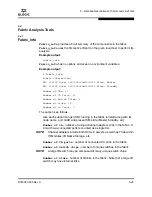
5 – Detailed Descriptions of Command LineTools
D000006-000 Rev A
5-39
Q
However,
iba_report
does not stop there. Additionally,
iba_report
has
reports that will help to analyze the operational characteristics of the fabric and
help to identify bottlenecks and faulty components in the fabric.
To assist in this area, iba_report also supports the following reports:
❥
slowlinks
- identifies links which are running slower than expected. This
helps to pinpoint bad cables or components in the fabric, such as a 4x cable
that is poorly-connected and therefore only runs at 1x link width. The analysis
includes both link speed and width.
❥
slowconfiglinks
- this extends on the slowlinks report to also report links
which have been configured (most likely by software) to run at a width or
speed below their potential. Such as DDR capable links which have been
forced to run at SDR rates.
❥
slowconnlinks
- this further extends on the slowconfiglinks report to also
report links which are cabled such that one of the ends of the link will never
run to its potential. Such as a DDR capable HCA connected to an SDR switch.
❥
misconfiglinks
- this is similar to
slowconfiglinks
in that it reports
links which have been configured to run below their potential. However it
does not include links which are running slower than expected.
❥
misconnlinks
- this is similar to
slowconnlinks
in that it reports links
which have been connected between ports of different speed potential.
However it does not include links which are running slower than expected,
nor links which have been configured to run slower than their potential.
❥
errors
- this performs a single point in time analysis of the PMA port counters
for every node and port in the fabric. All the counters are compared against
configured thresholds (defaults are those in the
iba_mon.conf
file). Any
link whose counters exceed these thresholds are listed (and depending on
the detail level the exact counter and threshold will be reported). This is a
powerful way to identify marginal links in the fabric such as bad or loose cables
or damaged components.
❥
route
- This permits the user to identify two end points in the fabric (by node
name, node GUID, port name, port GUID, system image GUID, LID, port GID,
IOC GIUD or IOC name) and obtain a list of all the links and components used
when these two end points communicate. If there are multiple paths between
the end points (such as a CA with 2 connected ports or a system with 2 CAs),
the route for every available path (based on presently configured routing
tables) will be reported.
The above set of reports can therefore be very powerful ways to obtain point in
time status and problem analysis for the fabric.
Summary of Contents for Fast Fabric
Page 1: ...D000006 000 Rev A Page i Q S i m p l i f y Fast Fabric Users Guide...
Page 2: ...Fast Fabric Users Guide Q Page ii D000006 000 Rev A...
Page 38: ...3 Getting Started Upgrading IB software 3 24 D000006 000 Rev A Q...
Page 148: ...6 MPI Sample Applications Pallas 6 6 D000006 000 Rev A Q...
Page 166: ...B Fast Fabric Configuration Files Port List Files B 14 D000006 000 Rev A Q...
Page 168: ...C Configuration of IPoIB Name Mapping C 2 D000006 000 Rev A Q...
















































